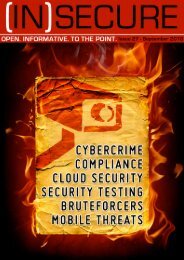Create successful ePaper yourself
Turn your PDF publications into a flip-book with our unique Google optimized e-Paper software.
The work “Above the Clouds,” published by<br />
the RAD Lab at UC Berkeley, has identified<br />
the three most common features of cloud<br />
computing:<br />
• The illusion of infinite computing resources<br />
available on demand, thereby eliminating the<br />
need for cloud computing users to plan far<br />
ahead for provisioning.<br />
• The elimination of an up-front commitment<br />
by cloud users, thereby allowing companies to<br />
start small and increase hardware resources<br />
only when there is an increase in their needs.<br />
• The ability to pay for use of computing resources<br />
on a short-term basis as needed<br />
(e.g., processors by the hour and storage by<br />
the day) and release them as needed, thereby<br />
rewarding conservation by letting machines<br />
Essentially, cloud computing makes resources<br />
available through the Internet and has three<br />
fundamental features, as noted above.<br />
The types of resources made available may<br />
be software (SaaS), a platform (PaaS), an infrastructure<br />
(IaaS), or storage (DaaS).<br />
Defining security problems on cloud<br />
servers<br />
Practically every expert in the industry approaches<br />
cloud computing with their own interpretation<br />
of the concept. As a result, after<br />
examining numerous published works on the<br />
Figure 1. The ontology of cloud services.<br />
and storage go when they are no longer useful.<br />
The specifications for building a cloud platform,<br />
such as virtualization, global distribution<br />
or scale, are not so much features of cloud<br />
computing, but merely help put this paradigm<br />
into practice. In particular, the use of virtualization<br />
technologies helps achieve the “illusion<br />
of infinite computing resources” mentioned<br />
above.<br />
The main features of any cloud service are the<br />
kinds of resources it offers users via the Internet.<br />
Depending on these resources, all services<br />
can be divided into a number of different<br />
categories (see Figure 1). Each of these carries<br />
the suffix *aaS, where the asterisk represents<br />
the letter S, P, I or D, and the abbreviation<br />
“aaS” means “as a service.”<br />
subject, one might get the impression that<br />
there is really no standardization at all. Questions<br />
regarding the security of Skype - a typical<br />
consumer cloud service - get jumbled up<br />
with the business aspects of installing SaaS,<br />
while Microsoft Live Mesh is already becoming<br />
a headache for companies that never even<br />
planned on using it in the first place.<br />
That!s why it would make complete sense to<br />
deconstruct the problem of cloud computing<br />
security into several high-level categories. In<br />
the end, all aspects of cloud service security<br />
can be put into one of four main categories:<br />
www.insecuremag.com 43





